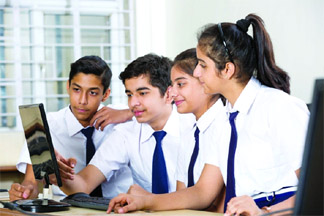Since gaining independence, India has placed significant emphasis on education as a means of fostering national development, social progress, and economic growth. Post-independence educational policies have aimed to expand access, promote equity, and enhance the quality of education across the country. India, a land steeped in rich cultural heritage, has a vibrant history of imparting knowledge and education dating back to ancient times. This nation has witnessed a massive transformation in its education system, evolving from traditional Gurukuls to modern schools and now to online colleges.
The first education system in India, dating back to 5000 BC, was the ‘Gurukula’ system. In this model, a student (shishya) would approach a teacher (Guru) for admission. If accepted, the student would stay with the Guru, assisting with household chores while learning practical skills, science, mathematics, philosophy, and metaphysics. This holistic education system emphasizes the development of human values and the practical implementation of knowledge to solve real-world problems.
However, the Gurukula system was eventually replaced by the modern school system introduced to India in 1830 by Lord Thomas Babington Macaulay. This system prioritized science and mathematics, with less emphasis on philosophy, ethics, moral values, and metaphysics. The medium of communication was also changed to English.
Current State of Education
in India: Facts & Figures
Under the 2020 amendment to India’s Right to Education Act, free and compulsory education is ensured for every child aged 3-18. Here are some statistics related to India’s education system:
26% of the Indian population, approximately 1.39 billion, falls within the primary education sector (0-14 years).
18% of the Indian population, roughly 500 million, fall within the secondary and higher education sector (15-24 years). The adult (15+ years) literacy rate in India is 69.3%, with male literacy at 78.8% and female at 59.3%.
Kerala boasts the highest literacy rate in India. University of Delhi is the most popular higher education institution in India, followed by IIT Bombay.
In the 2019 English Proficiency Index, India ranked 34th among 100 nations.
Future Prospects for India’s
Education System
India’s future aims for its education system are ambitious and progressive. Initiatives such as the United Nation’s E9 Initiative, launched in April 2021, aim to encourage digital learning, specifically targeting marginalized groups, particularly girls. The Union Budget of 2021-22 allocated $7.56 billion for school education and $5.28 billion for higher education. It is estimated that by 2030, more than 20 Indian higher education universities will rank among the top 200 universities globally.
In 2022, the degree of literacy in India was about 76.32 percent, with the majority of literate Indians being men. It is estimated that the global literacy rate for people aged 15 and above is about 86 percent. The overall prediction of literacy rate in 2024 is 85.95%.
Higher Education in Post Independence India
This period has witnessed the establishment of universities, colleges, and specialized institutions, the diversification of academic disciplines, and the implementation of policies aimed at democratizing higher education opportunities for all citizens.
Key Developments in Higher Education
Expansion of Higher Education Institutions: Post-independence India has witnessed a significant expansion of higher education institutions, including universities, colleges, and technical institutes. The establishment of institutions such as the Indian Institutes of Technology (IITs), Indian Institutes of Management (IIMs), and central universities has played a crucial role in promoting excellence in higher education and research.
Diversification of Academic Disciplines: Higher education in post-independent India has witnessed the diversification of academic disciplines, with the introduction of new fields of study and interdisciplinary approaches. Alongside traditional disciplines such as arts, science, and commerce, emerging areas such as engineering, management, information technology, and biotechnology have gained prominence. Promotion of Science and Technology: Recognizing the importance of scientific and technological advancements for national development, post-independent India has invested in the establishment of research institutions, engineering colleges, and scientific laboratories. Initiatives such as the Council of Scientific and Industrial Research (CSIR) and the Department of Science and Technology (DST) have played a pivotal role in fostering innovation and human capital development.
Affirmative Action and Social Inclusion: Post-independent India has implemented affirmative action policies such as reservations and scholarships to promote social inclusion and equity in higher education. Initiatives aimed at providing opportunities to historically marginalized communities, including Scheduled Castes (SC), Scheduled Tribes (ST), and Other Backward Classes (OBC), have contributed to increased access and representation in higher education.
Internationalization and Global Collaboration: Higher education institutions in post-independent India have increasingly embraced internationalization, forging collaborations with foreign universities, research institutions, and industry partners. International student exchanges, joint research projects, and academic partnerships have enriched the learning experience, promoted cross-cultural understanding, and facilitated knowledge transfer.
Challenges and Reforms
Despite significant progress, higher education in post-independent India faces several challenges, including issues related to access, quality assurance, curriculum relevance, employability, and equity. Reforms focusing on infrastructure development, faculty training, curriculum revision, research funding, and industry-academia collaboration are essential to address these challenges and enhance the effectiveness and relevance of higher education in India.
In conclusion, post-independence education in India has undergone significant transformations, driven by the goals of equity, access, and quality. While considerable progress has been made in expanding educational opportunities and improving literacy rates, persistent challenges remain, including disparities in access, unequal educational outcomes, and curriculum relevance. By addressing these challenges through inclusive policies, innovative pedagogies, and strategic investments, India can realize its vision of a robust and equitable education system that empowers individuals, fosters social cohesion, and drives sustainable development.
Development of education in India
